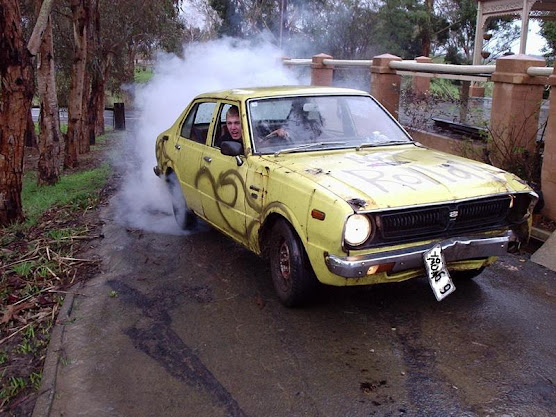Parvenu (pahr-vuh-noo or pahr-vuh-nyoo)
(1) A
person who has recently or suddenly acquired wealth, importance, position or
the like, but has not yet developed or acquired the conventionally appropriate manners,
dress, surroundings etc.
(2) Being
or resembling a parvenu; characteristic of a parvenu.
1802: From the from French parvenu (said of an obscure fellow (often from "the provinces") who has made a great fortune), noun use of the past participle of the twelfth century parvenir (to arrive), from the Latin pervenire (to come up, arrive, attain) the construct being per- (through) from the primitive Indo-European root per- (forward (thus “through")) + venire (to come) from a suffixed form of primitive Indo-European root gwa- (to go, come). Parvenu has been used as an adjective since 1828. In the French, parvenue is the feminine form; parvenu/parvenue is one of the few words in English with two forms distinguished according to gender although, in the anyway rare use, the masculine form, incorrect or not, is almost universal. Parvenu is a noun & adjective and parvenudom, parvenuess & parvenuism are nouns; the noun plural is parvenus. One imagines the adjective parvenuistic & adverb parvenuistically might be handy but no dictionaries list them as standard forms.
Parvenu and the more recent Australian invention CUB (cashed up bogan) do seem to mean much the same thing and there’s certainly some overlap but there are nuances. Both refer to those who have recently and suddenly become richer yet lack the cultural and social skills to match what is typically expected of those with wealth. However, conventions of use seem to suggest while a parvenu tends to come from the middle-class and is often an employee, a CUB is quintessentially from the trades and will likely be self-employed. The parvenu will drive an Audi, the CUB a pickup truck which by any standards will, to many, seem huge.
The parvenu and the CUB are terms laden with classism. The idea is of those newly arisen (ie the nouveau riche), especially if by some accident or luck or circumstances, being thought by those already there not worthy of their new assertion of status and despised for their attempts to persuade, the sort of people David Lloyd George (1863–1945; UK Prime Minister 1916-1922), speaking of his Liberal Party colleagues, called “jumped-up grocers”. The CUB by comparison is stereotypically unaware of or indifferent to the conventions of polite society and, content with materialism, makes little attempt socially to climb; should they take up golf, it's because they want to play the game, not just to belong to the "right club". That means they’re despised for other reasons; multiple huge televisions in vulgar houses thought not tasteful, hence the view it’s just appalling for such people to have money because they have not the taste to know how it should be spent. Snobs then, especially the poorer ones, look down on the nouveau riche while the pragmatic tend often not to worry so much about the "nouveau" as long as the "riche" is enough. As a social stratum, CUB has proved most useful for snobs because, unlike the English equivalent chav, there’s no linkage with ethnicity and thus no disapprobation visited upon those who apply the label, classism apparently not yet a suspect category among the woke.
The "Mean Girls" house.
Listed by RE/MAX Realtreon Barry Cohen Homes Inc, an ideal house for a parvenu has re-appeared on the market, made more desirable still by having a pop-culture pedigree, being the home of Regina George (Rachel McAdams (b 1978)) in Mean Girls (2004). Located in one of Toronto’s exclusive Bridle Path neighbourhood, the mansion has a total floor exceeding 18,000 square feet (1700 m3) and in configured with 13 bedrooms & 14 bathrooms; it would thus suit a large family or a couple with many friends who like to visit. Sited on a private, gated estate, the property covers two acres (.8 hectares) and includes staff quarters and a detached coach house with its own guest suite. Obviously big by domestic standards, it has appeared on the marked on a number of occasions over the last decade, offered for CND$14.8m in 2015 and not selling, despite a price cut of CND$2m some months later. It re-appeared in 2022, advertised at what was clearly an ambitious CND$27m, soon discounted to CND$23.8m, shortly raised by CND$100K. In 2024, the asking price is CND$19,995,000 (US$14.95m) and for that the buyer will get desirable features like cathedral ceilings and a twin “Scarlett O'Hara” staircase, similar in scale to the one some wedding venues use for photographs with the train of the bridal grown cascading down the treads. For those who focus on practicalities, the main bedroom’s walk-in closet is said to be bigger than many Toronto apartments and thus able to accommodate all but the most extravagant collectors of shoes and handbags while the garage can handle six cars, the driveway able comfortably to offer parking to another 20. Potential parvenu purchasers should run the numbers: annual running costs (excluding utilities but including insurance, taxes and staff costs) would exceed CND$220,000.








